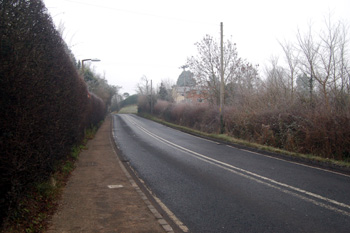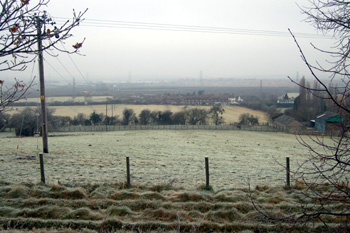The Parish of Billington in General

Great Billington from the Little Billington road January 2009
Landscape
Essentially the parish consists of the hill on which the settlement of Great Billington stands (it also lies at the northern and southern feet of the hill) and the surrounding, flatter countryside, including the hamlet of Little Billington at the western foot of the hill. The hill gets up to a little over four hundred feet above sea-level whilst the lower lying land around it averages 250 to 300 feet - Little Billington lies around 320 feet and the Stanbridge Road turn about 320 feet.
The River Ouzel flows through the south of the parish and the stream called Cocklake or Collick through the north. The underlying, or solid, geology is Gault Formation - a mudstone formed between 99 and 112 million years ago in the Cretaceous Period when the area was covered by warm, shallow seas. The top of the hill has soil which is known as till, the lower areas being clay.

The hill at Billington December 2008
Name
The name underwent some changes during the second millennium as noted in surviving documents:
- Billendon: 1196;
- Bilindon: 1196-1349;
- Bylindon: 1196-1349;
- Billesdon: 1202;
- Bilendon: 1227-1297;
- Bylendon: 1227-1297;
- Billingdon: 1276-1491;
- Billyngdon: 1276-1491;
- Bellendon: 1276;
- North Billingdone: 1287;
- Belyngdone: 1393-1394;
- Bellingdon: 1395-1491;
- Bellyngdon: 1395-1491;
- Billington: 1798 to the present.
The name means "Billa's Hill".

View towards Leighton Buzzard from Billington church December 2008
Administrative History
Billington was a Chapelry and hamlet in the larger parish of Leighton Buzzard. In 1810 the Chapelry became a separate, ecclesiastical parish and the hamlet became a separate civil parish in 1866. Early in the 21st century the parish lost an area of land to Leighton Buzzard due to the development of a large housing estate east of Billington Road on land which was up until then in Billington, as was the modern development including Newton Way and Roundel Drive to the west of RAF Stanbridge.
The boundary was then bent around these settlements, which were transferred to Leighton Buzzard, meaning that Billington reduced dramatically in terms of population. Billington is bordered by Leighton Buzzard to the north and west, Stanbridge to the north-east, Eaton Bray to the south-east and the Buckinghamshire parishes of Edlesborough to the south and Slapton to the south-west.
The name of the civil parish was always Billington, from its creation in 1867, which was also the name of the larger settlement on top of the hill, the hamlet to the west always being called Little Billington. Then, in the 1990s, there was local pressure to change the name of the main settlement to Great Billington, presumably because it sounder grander. This was agreed by Bedfordshire County Council in 1997. For a while Great Billington also became the name of the civil parish but this soon reverted to Billington. The ecclesiastical parish has remained simply Billington since its creation in 1810.

Old Grovebury Manor Farmhouse from the front January 2009
Population
Billington has never been a large parish but has waxed and waned over the last two hundred years, reaching a high point in 1861 of 484 then declining to a low point of 233 in 1921 as people left the land to move into towns, especially, one imagines, the fast growing towns of Leighton Buzzard and Linslade. Population then rose to a new high point of 634 in 2001 but the recent boundary change will have reduced it to somewhere closer to the immediately post war figure. The returns for the various censuses are as follows:
- 1801: 200;
- 1811: 225;
- 1821: 237;
- 1831: 271;
- 1841: 323;
- 1851: 456;
- 1861: 484;
- 1871: 475;
- 1881: 426;
- 1891: 350;
- 1901: 263;
- 1911: 247;
- 1921: 233;
- 1931: 242;
- 1951: 265;
- 1961: 633;
- 1971: 531;
- 1981: 520;
- 1991: 432;
- 2001: 634